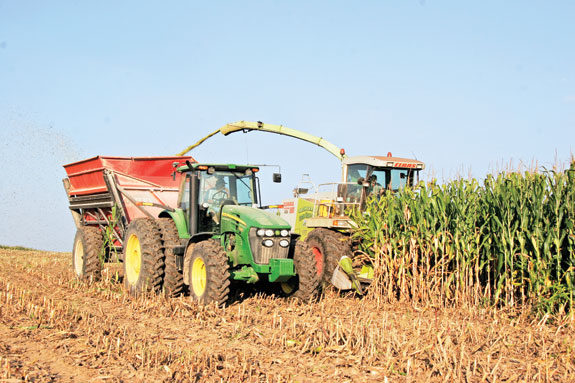Economically, corn silage is a great value as a feedstuff because it supplies both energy and structural fiber at a fairly low cost.
However, low cost should not equal low quality. It is critical to properly harvest and store corn silage to ensure a stable, reliable source of feed for formulating better rations for a dairy herd.
This article will highlight three key points for harvest that are critical to providing high-quality corn silage for your milking herd.
Whole-plant moisture level at harvest
The most important condition for proper corn silage harvest is the whole-plant moisture level. The best milk responses for corn silage, regardless of variety, are seen when corn is harvested from 65 percent to 68 percent moisture.
When corn is harvested for silage at higher moistures, then seepage (i.e. leaching) and poor fermentation characteristics begin to show up as major feeding challenges.
When corn is harvested too dry, then fermentation does not achieve expected levels. Moisture content should be adjusted to match the storage structure to produce the best-quality silage.
Determining moisture level
Visually looking at a corn plant is not an accurate method to determine harvest. A starting point to begin monitoring plant moisture levels is when the ear begins to dent.
At this stage sugar in the kernel is being converted into starch and the kernel begins to shrink. When the milk line, which shows the change from milky starches to hard starch in the kernel, is half of the way down the kernel, whole-plant moistures will be close to optimum moisture levels, on average 63 percent.
Unfortunately crop moisture levels can vary greatly across hybrids and locations at half milk line, (ranges – 53 to 73 percent). Do not depend on this method for accurate moisture levels.
The best method is to cut representative stalks, shred them and run an accurate moisture determination test. After denting, whole-plant moisture levels will decrease approximately 0.6 percent per day.
Silage harvest can be predicted but additional monitoring of moisture will be needed. As plant moistures approach 62 percent, the dry-down rate rapidly increases. Don’t get caught with too-dry silage.
Length of cut
Recommendations for length of cut for silage vary depending on crop condition. Drier crops should be cut finer to produce smaller particles that minimize air pockets.
Use of highly digestible hybrids requires a slightly longer cut to maintain effective fiber. General recommendation for corn being chopped for silage without processing is a 3/8-inch theoretical length of cut (TLC), but more mature crops may require a shorter length.
For processed corn silage the recommended chop length is 5/8- to 3/4-inch TLC. Some farms rely on their nutritionists to fine-tune the chop length based on farm-specific conditions.
Processing silage
At lower whole-plant moistures, crop maturity may affect silage quality. Fiber and starch digestion decreases as corn dries down.
Processing at harvest may be needed to maximize digestion on more mature crops. Given the cost of energy feedstuffs in today’s market, all corn silage should be processed if possible.
The goal of processing is to ensure breakage of the kernel and cob to assist digestion. Processing also can affect fiber length so choppers equipped with a processor typically lengthen their cut to 3/4-inch.
Recommended processor settings for corn silage are 2 to 3 mm depending on the TLC and the moisture of the crop. Drier corn requires more processing (i.e. 1 - 2 mm).
After harvest
Once the chopped corn is sealed in the storage structure, it should be ensiled for a minimum of three weeks prior to feeding to ensure that fermentation runs to completion. However, research has shown that allowing corn silage to stay in storage longer will improve digestibility of both starch and fiber.
Wisconsin research has shown that maximum starch digestibility is reached at nine to 10 months of storage while maximum fiber digestibility is reached at 10 to 11 months of storage.
Carryover of corn silage to these levels is likely not practical on most farms, but efforts should be made to let new corn silage stay in storage as long as possible prior to opening the silo. This is one case where being less “green” is preferable. FG
—Excerpts from Penn State Dairy Digest, Vol. 10, No. 4













